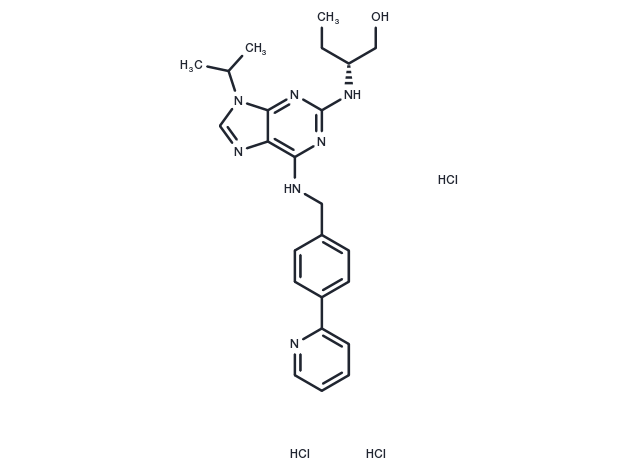keep away from moisture
Powder: -20°C for 3 years | In solvent: -80°C for 1 year

(R)-CR8 trihydrochloride (CR8, (R)-Isomer trihydrochloride) is a CDK1/2/5/7/9 inhibitor that acts as a molecular glue degrader with neuroprotective activity and induces apoptosis.

| Pack Size | Availability | Price/USD | Quantity |
|---|---|---|---|
| 1 mg | In stock | $ 32.00 | |
| 5 mg | In stock | $ 70.00 | |
| 10 mg | In stock | $ 100.00 | |
| 25 mg | In stock | $ 163.00 | |
| 50 mg | In stock | $ 238.00 | |
| 100 mg | In stock | $ 355.00 | |
| 1 mL * 10 mM (in DMSO) | In stock | $ 87.00 |

| Description | (R)-CR8 trihydrochloride (CR8, (R)-Isomer trihydrochloride) is a CDK1/2/5/7/9 inhibitor that acts as a molecular glue degrader with neuroprotective activity and induces apoptosis. |
| Targets&IC50 | CK1δ/ε:0.4 μM, CDK9-CyclinT1:0.18 μM, CDK2-CyclinE:0.041 μM, CDK1:0.09 μM, CDK5-p25:0.11 μM, CDK7-CyclinH:1.1 μM, CDK2:0.072 μM |
| In vitro | In the SH-SY5Y cell line, (R)-CR8 trihydrochloride (0.1, 1, 10, 100 μM; 24 hours) reduced cell survival in a dose-dependent manner[1]. |
| In vivo | In 10 to 12-week-old male Sprague-Dawley rats (310 to 330 g), administration of (R)-CR8 trihydrochloride at 5 mg/kg (i.p.) resulted in a significant reduction in lesion size[2]. |
| Synonyms | CR8, (R)-Isomer trihydrochloride |
| Molecular Weight | 540.92 |
| Formula | C24H32Cl3N7O |
| CAS No. | 1786438-30-9 |
keep away from moisture
Powder: -20°C for 3 years | In solvent: -80°C for 1 year
DMSO: 30 mg/mL (55.46 mM), Sonification is recommended.
You can also refer to dose conversion for different animals. More
bottom
Please see Inhibitor Handling Instructions for more frequently ask questions. Topics include: how to prepare stock solutions, how to store products, and cautions on cell-based assays & animal experiments, etc.
(R)-CR8 trihydrochloride 1786438-30-9 Apoptosis Cell Cycle/Checkpoint CDK (R)-CR-8 trihydrochloride (R)CR8 trihydrochloride CR-8 Trihydrochloride CR 8 (R) CR8 trihydrochloride CR8, (R)-Isomer trihydrochloride CR8, Isomer (R)-CR8 trihydrochloride CR 8 Trihydrochloride CR8 CR8 Trihydrochloride CR8, Isomer Trihydrochloride CR-8 inhibitor inhibit
